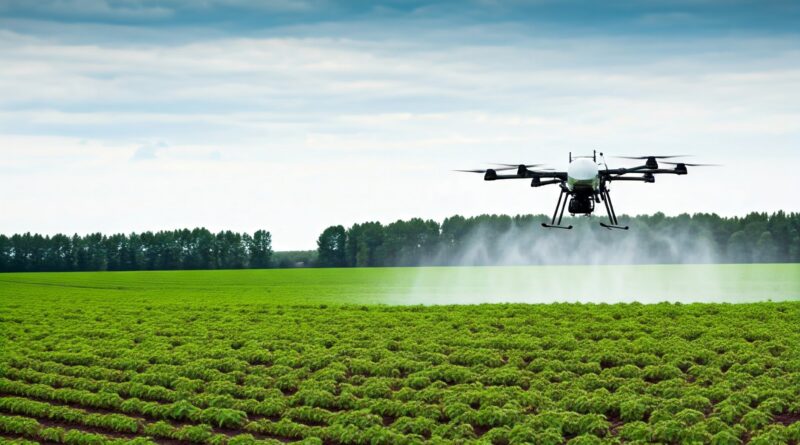Drones in Agriculture: Innovations and Applications
Drones in Agriculture: Innovations and Applications
In recent years, the advent of drone technology has transformed various industries, and agriculture is no exception. As the global population continues to rise, the demand for food production increases, placing significant pressure on agricultural systems. To meet these challenges, farmers and agricultural professionals are turning to drones for innovative solutions. This blog post delves into the various innovations and applications of drones in agriculture, providing insights into how this technology is shaping the future of farming.
The Rise of Agricultural Drones
The integration of drones into agriculture has been nothing short of revolutionary. According to a report by MarketsandMarkets, the agricultural drone market is expected to reach USD 5.7 billion by 2025, growing at a CAGR of 31.4% from 2020 to 2025. This growth is driven by the need for precision agriculture, resource optimization, and increased efficiency.
Precision Farming: Enhancing Crop Management
One of the most significant applications of drones in agriculture is precision farming. With the ability to capture high-resolution images and data, drones help farmers monitor crop health, soil conditions, and water needs. For example, using multispectral sensors, drones can detect areas of a field that require more nutrients, enabling targeted fertilization and reducing waste. This not only boosts crop yields but also minimizes environmental impact.
Planting and Seeding: A New Approach
Drones are also being used for planting and seeding, offering a quicker and more efficient method compared to traditional techniques. Companies like BioCarbon Engineering are leveraging drone technology to plant trees at a rate of 100,000 per day. By using drones, farmers can reforest areas and plant crops in hard-to-reach locations, significantly reducing labor costs and time.
Check Prices On Amazon
Innovative Applications of Drones in Agriculture
Crop Monitoring and Health Assessment
Drones equipped with sensors and cameras provide real-time data on crop conditions. This information helps farmers make informed decisions regarding irrigation, pest control, and fertilizer application. A study by the International Journal of Agricultural and Biological Engineering found that drone-based crop monitoring improved yield prediction accuracy by up to 95%.
Irrigation Management
Water is a precious resource, and efficient irrigation is critical for sustainable agriculture. Drones are equipped with thermal cameras to assess soil moisture levels, enabling farmers to implement precise irrigation strategies. This ensures that crops receive the right amount of water, improving growth and conserving water resources.
Pest and Disease Control
Drones offer an innovative solution for pest and disease control. Using advanced imaging technology, drones can identify pest infestations or disease outbreaks early, allowing for timely intervention. This reduces the need for chemical pesticides and promotes healthier crop growth.
Challenges and Considerations
Regulatory and Safety Concerns
While drones offer numerous benefits, their use is subject to regulatory restrictions. Farmers must navigate FAA regulations and obtain necessary permissions, especially for commercial operations. Safety concerns, such as avoiding collisions with manned aircraft, must also be addressed.
Data Management and Analysis
Collecting data with drones is only part of the equation. Farmers must also have the tools and knowledge to analyze this data effectively. Investing in software and training is essential to convert drone data into actionable insights.
Actionable Tips for Implementing Drones in Agriculture
Start Small
For farmers new to drone technology, starting with small-scale applications can be beneficial. Begin with simple tasks like crop monitoring and gradually expand to more complex operations as familiarity with the technology grows.
Invest in Training
Proper training is crucial for maximizing the potential of drones. Consider enrolling in courses or workshops that focus on drone operation, data analysis, and precision agriculture techniques.
Partner with Experts
Collaborating with agricultural consultants or drone service providers can provide valuable expertise and support, ensuring successful implementation and integration of drone technology on your farm.
Check Prices On Amazon
Conclusion
Drones are proving to be a game-changer in the field of agriculture, offering innovative solutions that enhance productivity, conserve resources, and support sustainable farming practices. As technology continues to evolve, the potential applications of drones in agriculture are limitless. By embracing this technology, farmers can meet the challenges of modern agriculture and secure a more productive future. Whether through precision farming, efficient irrigation, or targeted pest control, drones are paving the way for a new era of agricultural innovation.
As you consider integrating drones into your agricultural practices, remember that the key to success lies in understanding the technology, planning strategically, and leveraging expert insights. With these elements in place, drones can become a powerful tool in your farming arsenal.

